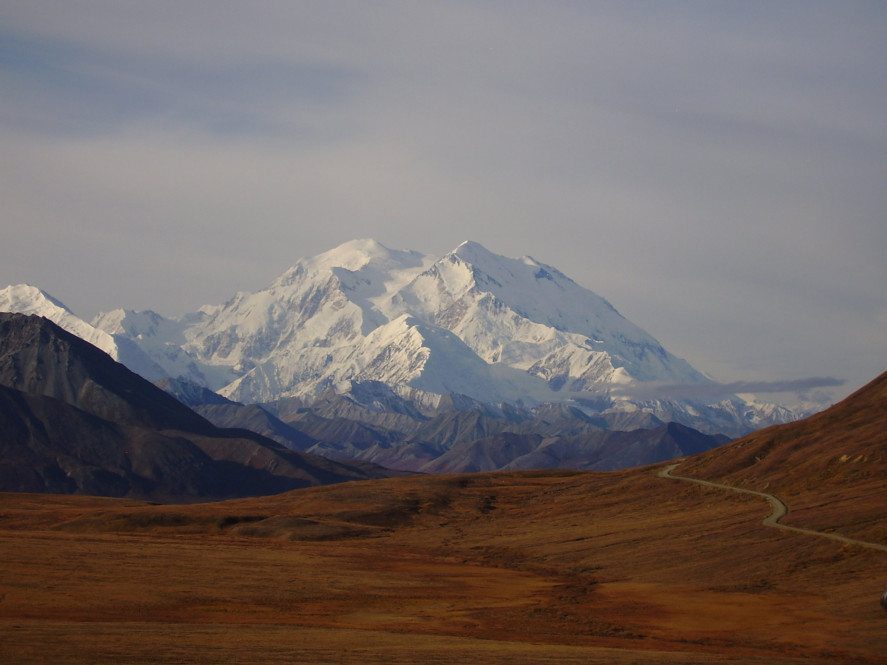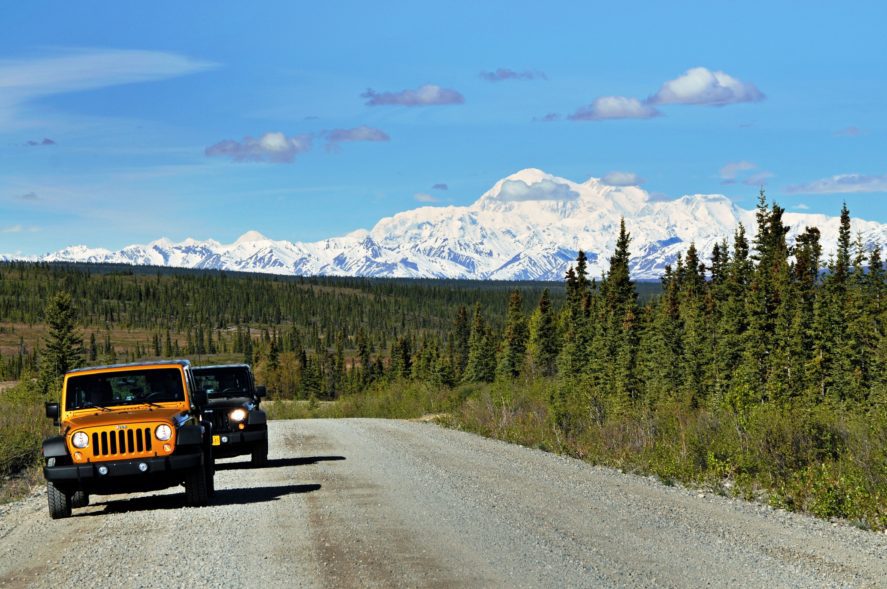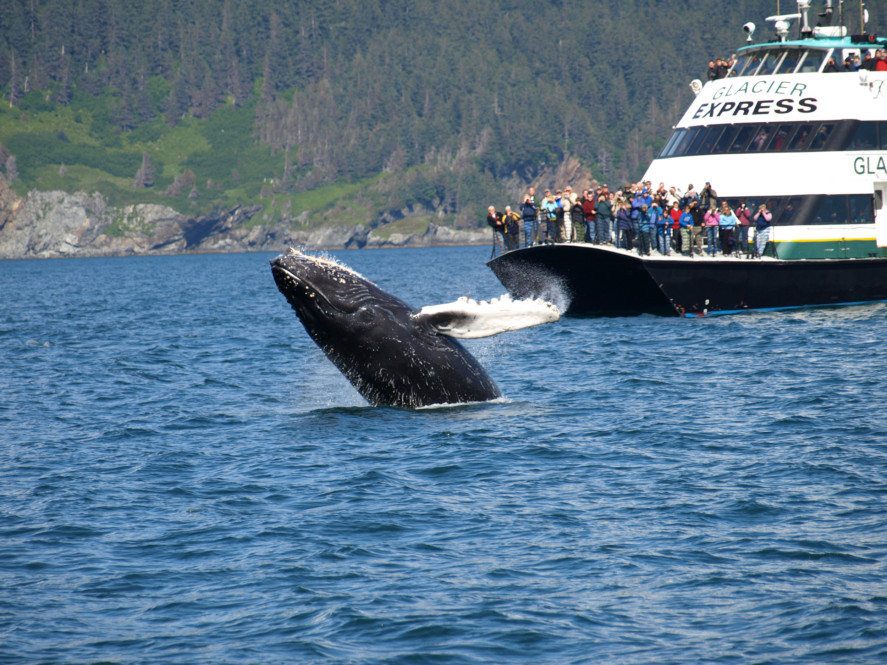At Alaska Tours, over our 30+ year history, we’ve been asked lots of questions by visitors planning their trips. Road trippers, in particular, as well as those who enjoy driving themselves to and around Alaska tend to wonder about and often ask the following questions about driving to and around Alaska during the summer months.
What is it like to drive on Alaska’s roadways?
Most of Alaska’s major highways, roads and streets are paved and in good condition. There are plenty of gas stations all along your route but beware, Alaska speed limits are enforced dutifully. Most of the highways are two lanes and the scenery is always simply stunning.

Summer drivers in Alaska need to have a deeper sense of patience than in most other places. Summer in Alaska means increased traffic on roadways, including many large (and slower) recreational vehicles, campervans and big trucks/SUVs pulling travel trailers (perhaps you’re driving one of these?), in addition to Alaskans hauling trailers with four-wheelers for hunting, boats for fishing, and materials for whatever they’re building. It’s not unusual for summer drivers to noticeably cruise under the speed limit … but they’re not necessarily bad drivers. Most are looking for an opportunity to pull off road to take in the incredible scenery and look for wildlife. Pass and proceed with care. Slower vehicles should simply pull over as soon as a line of vehicles starts stacking up behind them.

Summer in Alaska also means construction season on many roadways, so delays are not unusual: some are just a few minutes, some are lots of minutes. Visit Alaska 511 (https://511.alaska.gov) before your road trip for information on current construction, potential delays and road conditions. And even the best roads can suffer the occasional frost heave, which come in the form of surprisingly big bumps or deep dips – you don’t want to hit one of these at fast speeds in any vehicle.
And like anywhere else, you should remain vigilant and keep your eyes on the road in anticipation of what could happen. It helps to drive a little slower than the speed limit, with headlights on, allowing other drivers see you in any of Alaska’s unpredictable weather conditions. Another tip: always look out for wildlife, which can occasionally wander onto roads! From tiny, fast-moving squirrels and rabbits to large, sturdy and slow-moving caribou, moose and even bears, the last thing you want to do is figuratively and literally run into one of these animals. At best, it will be a sudden, dangerous swerve or a major bummer running over a rodent. At worst, it could be destructive or deadly to the animal and even the driver and passengers inside the vehicle.
Do I need an SUV or 4WD to get around in Alaska?
Most likely not. Again, most of Alaska’s main roadways leading to the state’s main attractions, are paved. The roads in Alaska that aren’t paved are gravel or dirt but are usually in good to excellent condition. With that said, read rental car agreements closely before choosing and driving routes. The majority of rental car operators forbid driving their vehicles beyond Alaska’s paved roads. Do so and face potential breakdowns and vehicle damage, as well as a potential fines/penalties.

Denali Highway Jeep Excursion
There are a few rental outfits that allow drivers to take their gravel-road-friendly vehicles (trucks and SUVs) beyond paved roads. If you’re driving one of those, your own vehicle or a friend’s around Alaska, you’ll certainly increase your opportunities for venturing out on the further, sometimes rougher reaches of the state’s roadways that most rental car agreements forbid: the second half of the Elliott Highway, which eventually turns into the iconic and also gravel Dalton Highway/Haul Road; the majority of the Denali Highway; the majority of the Steese Highway; and the McCarthy Road from Chitina and McCarthy. Maybe you’re driving out to a cabin deep in the woods or a secret fishing spot off of a main road. In those cases, a four-wheel drive vehicle will most often keep you on the go and out of trouble.
Do I need a GPS device?
Probably not. While Alaska might be massive, its road system is pretty simple. Also, cell service ranges from good to great on most stretches of major Alaska roadways, so you can usually use a phone/cell-based map app if needed. Just note that if you’re driving a personal vehicle, the further you get from the main roadways, the less likely you are to get a cell signal and data. Take that into consideration and map your trip accordingly before hitting the road. A simple, old-school paper map will more than suffice for most Alaska road trips. Ironically, the places in Alaska a driver would most want to use GPS and map apps would be in urban areas like Anchorage and Fairbanks – major towns with many streets and countless interesting destinations.

How do I find a rental car to drive in Alaska?
For the most part, renting a car in Alaska is just like renting a vehicle anywhere else. If you’re traveling into any major Alaska community or hub airport, there will be rental car options, from the usual lineup of well-known, national brands to smaller local mom and pop shops. Do your online research but before you commit, though, get to know specific contract agreements, especially where you can and can’t drive your rental vehicle. Summer is the busiest time in Alaska and that certainly translates to the availability and pricing of rental vehicles. Plan and book your car rental as early as possible to ensure the rental you want, or a rental at all, at the best price.
Can I drive my own car to Alaska?
Yes, as long as your driver’s license and vehicle registration and necessary paperwork are up to date, you can drive your own vehicle in Alaska. The freedom and luxury of having your own vehicle in Alaska provides a level of flexibility and affordability for Alaska visitors, while also opening up an assortment of adventures that rental car agencies may not allow. If you’re crossing through Canada, don’t forget to check COVID-19 restrictions and bring your passport. You won’t be allowed into Canada or back into America without it. You should also do some research on what items can and can’t be brought across those boarders, and which items require additional paperwork for entry (pets, firearms, etc.).
Can I drive the Denali Highway?
If you’re driving a rental car, that’s pretty much a “no,” as rental contracts typically exclude driving on unpaved roads, and the majority of the Denali Highway is unpaved. While most of that unpaved portion is smooth going, some of it can be rough and tough on rides. If you’re driving your own vehicle or rent one that is allowed passage on the Denali Highway, you can certainly drive the beautiful route in the summer, but do so prepared for ruts, rocks, dust, hills, slow-moving vehicles and even flat tire(s). In the winter, the Denali Highway is becomes a snowmobile thoroughfare.
Can I drive in Denali National Park?
Yes … but that answer comes with two big caveats. First, during the summer, the public is only allowed to drive on the first 15 miles of the incredible 92-mile Denali Park Road. From Mile 15 on, the rest of the road into the heart of Denali National Park is closed to public vehicles and offers access only to approved bus operators. Second, there is a second Denali Park Road driving opportunity in the fall when the Park opens the entire route to a small group of its Road Lottery winners. Lottery winners are assigned one of four September days to drive the road as far as weather and conditions allow; sometimes that’s easily all the way, sometimes September snow closes the road well before its end. Your odds of winning this lottery are slim: 2019’s winner pool consisted of only 400 vehicles per day.

Caribou in Denali (c) Jeff Schultz/Schultzphoto.com/ALL RIGHTS RESERVED
What do you do if you have a problem on your Alaska driving route and you don’t have cell phone coverage?
Be calm and patient, turn on your flashers and try to pull over to a safe area off of the road – there are many areas to pull-off along Alaska’s major highways. If your vehicle is stopped fully or partially on the road, use flares and/or florescent emergency markers well behind the vehicle to let fellow drivers know to slow down before they reach you. Thankfully, summer means lots of drivers are on the road, which also means you probably won’t wait long until someone passes by. If you wave them down, many will stop to offer a hand, a ride or a promise to make a call for you to the nearest community’s auto shop when they reach cell service. Alaskans are particularly understanding and helpful in situations like these.
What is the Alaska Marine Highway?
The Alaska Marine Highway is a system of beautiful routes that takes travelers to some of the state’s most remote and interesting coastal communities, islands and outposts. Yet it’s a traditional “highway” in name only. The Alaska Marine Highway System is operated exclusively on waterways by a system of ferries, so you won’t be driving this highway. While you can’t drive it, adventurous travelers can pull their vehicle into the belly of most ferries for a fee and get dropped off at one of those unique destinations. If you are renting a car, however, do check your contract before booking a ferry trip.

Humpback whale breaking in front of a Major Marine touring vessel.
